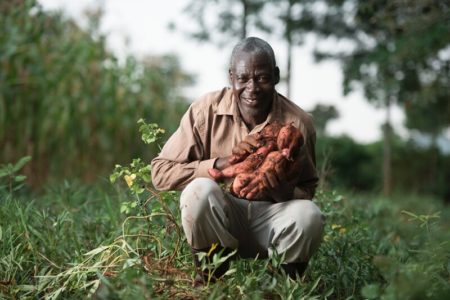A new paper released at the 2020 World Food Prize today charts important progress in the global fight against malnutrition and nutrition insecurity. Challenges remain but numerous gains have been recorded over the past 15 years in delivering more densely nutritious food to the world’s most vulnerable groups.
The term “hidden hunger” refers to a diet that is sufficient in calories but deficient in vitamins and nutrients needed for proper growth and maturation. In many places around the world, caloric needs are being met but nutrition lags behind, placing populations at risk for illness and underdevelopment, especially children and pregnant and lactating women. Beyond the health implications of hidden hunger, deficient nutrition also has long-term negative impacts on economic growth and social development.

Biofortification, proven in addressing hidden hunger, is a process of increasing the density of minerals and vitamins in a food crop through conventional plant breeding, transgenic techniques, or agronomic practices. Biofortified staple food crops, when consumed regularly, can generate measurable improvements in human nutrition and health. For example, the International Potato Center’s Jan Low helped develop sweetpotato varieties that deliver a full complement of vitamin A in just 125 grams, a portion easily consumed by young children.
At a World Food Prize side event this morning, an esteemed group of international researchers gathered to announce the launch of a new publication providing evidence-based case studies to support the advantages of biofortification. The paper and event are sponsored by the Council for Agricultural Science and Technology.
The group features two former World Food Prize laureates: Low and Howarth Bouis of the International Food Policy Research Institute (IFPRI), both of whom received their award for their pioneering work on biofortified crops. Today, the portfolio of biofortified crops also includes rice, wheat, maize, cassava, pearl millet and others.
Bouis opened the event telling the online audience that, to be successful, biofortification needed to answer four questions about cost-effectiveness, nutrition, breeding and delivery. The CAST paper, he said, included data and findings to answer all four questions in the positive.
Matin Qaim of the University of Goettingen described the economic advantages of biofortification. While supplements and industrial fortification of foods are two ways to battle malnutrition, these options have recurrent costs year after year. Because crops are grown in the next season using the seeds from the previous harvest, biofortification builds the improved nutrition into the growing cycle. In this way, Qaim said, “We get the plants to do the work of vitamins and supplements without extra expense.” To buttress this point, Qaim provided a graphic that showed well over half of tested biofortification interventions displayed a cost well below the World Bank standard[1] for cost effectiveness.
 Saurabh Mehta of Cornell University addressed the issue of biological impact of nutrition delivery. Surveying a collection of studies, Mehta found that biofortified crops had consistently demonstrated high absorption rates and high storage rates in biomarkers, meaning that those consuming biofortified foods were found to have appropriate levels of the intended vitamins and micronutrients. Other studies found that biofortified crops led to improved physical and cognitive outcomes for children.
Saurabh Mehta of Cornell University addressed the issue of biological impact of nutrition delivery. Surveying a collection of studies, Mehta found that biofortified crops had consistently demonstrated high absorption rates and high storage rates in biomarkers, meaning that those consuming biofortified foods were found to have appropriate levels of the intended vitamins and micronutrients. Other studies found that biofortified crops led to improved physical and cognitive outcomes for children.
The key to breeding lies in the success of the breeding and the technologies available to plant breeders. On this point, Torbert Rochford of Purdue University expressed great enthusiasm as breeding for micronutrients dates back only 15 years and he is confident that emerging technologies will accelerate current processes even more. To date, he said, 240 varieties of biofortified crops have been distributed in more than 30 countries around the world. And the nutrition levels are considerable: beans and pearl millet pack up to 80% of daily iron needs.
But for all these economic and scientific advances, the grander project of biofortification will fail if these crops do not reach those who need them. To that end, Jan Low of CIP discussed scaling up delivery strategies so that biofortified foods reach and find acceptance in the marketplace. Low stressed the need to involved farmers and consumers in the development of new varieties.
“But the greatest challenge we face in delivery of biofortified crops is the seed system bottleneck. We need to replace informal systems with trained small farming entrepreneurs who can cultivate and sell certified seed,” she warned.
Once biofortified crops reach the marketplace, Low said, it is important to promote these foods through a variety of strategies including branding, certification labeling, and even endorsements from national celebrities. In this way, the value chain can be solidified from start to finish.
“If we want farmers to buy biofortified seed, they must be convinced the consumers will be there. So, we need to promote consumption in the marketplace,” Low said.
Ekin Birol of Harvest Plus and Dominique Van Der Straeten of Ghent University rounded out the session describing the future of biofortified crops in terms of policy support and further advances in technology. While the World Food Programme and several UN agencies recommend biofortified foods, Birol said future success could be amplified if biofortification were included in national agricultural policies, attached as requirements for international loan programs, or required for food assistance in humanitarian programs.
Council on Agricultural Science and Technology website
CAST paper on biofortification
[1] USD 270 per Disability-Adjusted Life Year (DALY) saved.
